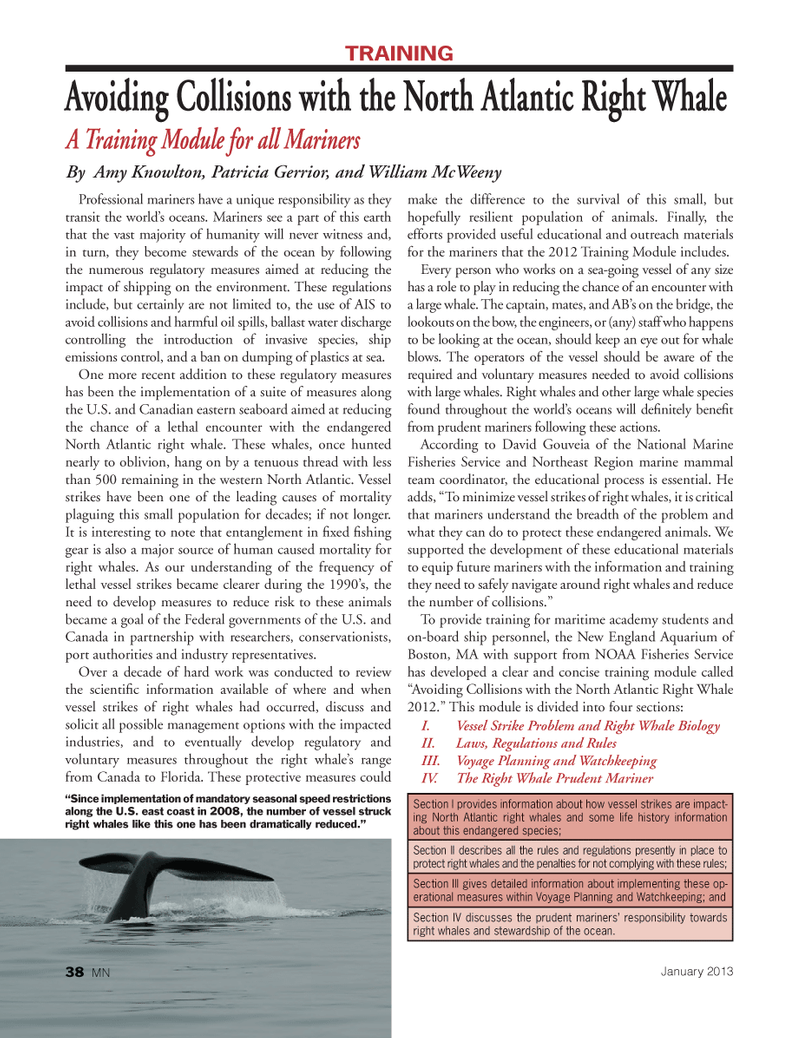
Page 38: of Marine News Magazine (January 2013)
Training and Education
Read this page in Pdf, Flash or Html5 edition of January 2013 Marine News Magazine
Professional mariners have a unique responsibility as they transit the world?s oceans. Mariners see a part of this earth that the vast majority of humanity will never witness and, in turn, they become stewards of the ocean by following the numerous regulatory measures aimed at reducing the impact of shipping on the environment. These regulations include, but certainly are not limited to, the use of AIS to avoid collisions and harmful oil spills, ballast water discharge controlling the introduction of invasive species, ship emissions control, and a ban on dumping of plastics at sea. One more recent addition to these regulatory measures has been the implementation of a suite of measures along the U.S. and Canadian eastern seaboard aimed at reducing the chance of a lethal encounter with the endangered North Atlantic right whale. These whales, once hunted nearly to oblivion, hang on by a tenuous thread with less than 500 remaining in the western North Atlantic. Vessel strikes have been one of the leading causes of mortality plaguing this small population for decades; if not longer. It is interesting to note that entanglement in xed shing gear is also a major source of human caused mortality for right whales. As our understanding of the frequency of lethal vessel strikes became clearer during the 1990?s, the need to develop measures to reduce risk to these animals became a goal of the Federal governments of the U.S. and Canada in partnership with researchers, conservationists, port authorities and industry representatives. Over a decade of hard work was conducted to review the scienti c information available of where and when vessel strikes of right whales had occurred, discuss and solicit all possible management options with the impacted industries, and to eventually develop regulatory and voluntary measures throughout the right whale?s range from Canada to Florida. These protective measures could make the difference to the survival of this small, but hopefully resilient population of animals. Finally, the efforts provided useful educational and outreach materials for the mariners that the 2012 Training Module includes. Every person who works on a sea-going vessel of any size has a role to play in reducing the chance of an encounter with a large whale. The captain, mates, and AB?s on the bridge, the lookouts on the bow, the engineers, or (any) staff who happens to be looking at the ocean, should keep an eye out for whale blows. The operators of the vessel should be aware of the required and voluntary measures needed to avoid collisions with large whales. Right whales and other large whale species found throughout the world?s oceans will de nitely bene t from prudent mariners following these actions. According to David Gouveia of the National Marine Fisheries Service and Northeast Region marine mammal team coordinator, the educational process is essential. He adds, ?To minimize vessel strikes of right whales, it is critical that mariners understand the breadth of the problem and what they can do to protect these endangered animals. We supported the development of these educational materials to equip future mariners with the information and training they need to safely navigate around right whales and reduce the number of collisions.?To provide training for maritime academy students and on-board ship personnel, the New England Aquarium of Boston, MA with support from NOAA Fisheries Service has developed a clear and concise training module called ?Avoiding Collisions with the North Atlantic Right Whale 2012.? This module is divided into four sections: I. Vessel Strike Problem and Right Whale Biology II. Laws, Regulations and Rules III. Voyage Planning and Watchkeeping IV. The Right Whale Prudent Mariner Section I provides information about how vessel strikes are impact- ing North Atlantic right whales and some life history information about this endangered species; Section II describes all the rules and regulations presently in place to protect right whales and the penalties for not complying with these rules; Section III gives detailed information about implementing these op-erational measures within Voyage Planning and Watchkeeping; and Section IV discusses the prudent mariners? responsibility towards right whales and stewardship of the ocean. Avoiding Collisions with the Avoiding Collisions with the North Atlantic Right Whale North Atlantic Right Whale A Training Module for all Mariners A Training Module for all Mariners By Amy Knowlton, Patricia Gerrior, and William McWeeny ?Since implementation of mandatory seasonal speed restrictions along the U.S. east coast in 2008, the number of vessel struck right whales like this one has been dramatically reduced.? TRAININGJanuary 2013 38 MNMN Jan2013 Layout 32-42.indd 38MN Jan2013 Layout 32-42.indd 381/8/2013 4:28:57 PM1/8/2013 4:28:57 PM

 37
37

 39
39
